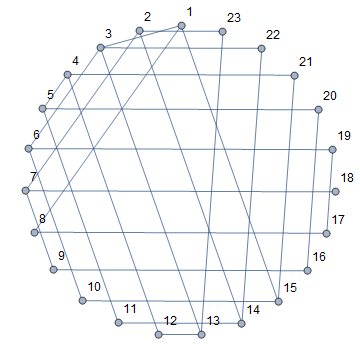I have tried things like
With[{coords=Most@With[{n=23,\[Theta] = LambertW[1] },
N@(Table[{{Re[E^( I \[Theta])], -Im[E^( I \[Theta])]},
{Im[E^( I \[Theta])], Re[E^( I \[Theta])]}}.{Re[ E^(I (1 + 2 \[Pi] ii/n))],
Im[E^(I (1 + 2 \[Pi] ii/n))]}, {ii, Join[{n}, Range[n]]}])]},
Graph[{1 -> 3, 2 -> 7, 3 -> 6, 4 -> 5, 5 -> 11, 6 -> 10, 7 -> 9, 8 -> 17,
9 -> 16, 10 -> 15, 11 -> 14, 12 -> 13, 13 -> 23, 14 -> 22, 15 -> 21,
16 -> 20, 17 -> 19, 18 -> 7, 19 -> 6, 20 -> 5, 21 -> 4, 22 -> 3,
23 -> 2, 8 -> 1, 12 -> 4, 13 -> 3, 14 -> 2, 15 -> 1},
DirectedEdges -> False, VertexLabels -> "Name", VertexCoordinates->coords ]]
which generates a graph with vertices out of order (I suppose coords must not be generated as I expected)

I have tried other things like GraphLayout -> {"CircularEmbedding"}, but that doesn't work either.
Have even tried
n=23;With[{coords=With[{polygon=Most@With[{\[Theta] = LambertW[1] },
N@(Table[{{Re[E^( I \[Theta])], -Im[E^( I \[Theta])]},
{Im[E^( I \[Theta])], Re[E^( I \[Theta])]}}.{Re[ E^(I (1 + 2 \[Pi] ii/n))],
Im[E^(I (1 + 2 \[Pi] ii/n))]}, {ii, Join[{n}, Range[n]]}])]},
With[{ points = N@RandomSample[Join[polygon, {{0, 0}}]]},
With[{ chm=ConvexHullMesh[points]},
With[{ ordering=MeshCells[chm,2][[1,1]]},
MeshCoordinates[chm][[ordering]]]]]]},
Graph[{1 -> 3, 2 -> 7, 3 -> 6, 4 -> 5, 5 -> 11, 6 -> 10, 7 -> 9, 8 -> 17,
9 -> 16, 10 -> 15, 11 -> 14, 12 -> 13, 13 -> 23, 14 -> 22, 15 -> 21,
16 -> 20, 17 -> 19, 18 -> 7, 19 -> 6, 20 -> 5, 21 -> 4, 22 -> 3,
23 -> 2, 8 -> 1, 12 -> 4, 13 -> 3, 14 -> 2, 15 -> 1},
DirectedEdges -> False, VertexLabels -> "Name", VertexCoordinates->coords ]]
so I don't think its a problem with coords, but with graph order.




Graphcase. $\endgroup$